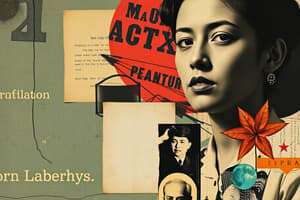Podcast
Questions and Answers
What is literature derived from?
What is literature derived from?
The Latin term 'litera' which means letter.
How was pre-colonial literature primarily transmitted?
How was pre-colonial literature primarily transmitted?
Through oral tradition.
Match the following literary forms with their descriptions:
Match the following literary forms with their descriptions:
Riddles = Battle of wits among participants Proverbs = Wise sayings that contain metaphor used to teach a lesson Folk songs = One of the oldest forms of pre-colonial literature Myths = Stories that explain how the world was created
The first Filipino alphabet called baybayin is still used today.
The first Filipino alphabet called baybayin is still used today.
What was the first published book in the Philippines?
What was the first published book in the Philippines?
What was a primary focus of literary themes during the Spanish Colonial period?
What was a primary focus of literary themes during the Spanish Colonial period?
What materials did early Filipinos write on?
What materials did early Filipinos write on?
What structure identifies an 'Awit'?
What structure identifies an 'Awit'?
Which literary output gained a religious tone during the Spanish colonization?
Which literary output gained a religious tone during the Spanish colonization?
Flashcards are hidden until you start studying
Study Notes
Definition of Literature
- Derived from Latin "litera," meaning letter; encompasses ideas, thoughts, and emotions.
- Defined as written works acknowledged as art, including novels, plays, and poems.
- Refers to writings that explore the meanings of nature and life with artistic charm and power.
- Functions as an enriching art form, enhancing reality rather than merely depicting it.
Pre-Colonial Literature
- Primarily transmitted via oral tradition; limited written records.
- Early written forms were often destroyed by Spanish colonizers; some texts survived due to geographical isolation.
- Writing materials included palm leaves and bamboo, with knives as pens and plant sap as ink.
- Ancient Tagalog script consisted of 17 basic syllables, featuring three vowels and fourteen consonants.
- Literary characteristics: communal subject matter, communal authorship, formulaic repetitions, stereotyped characters, and rhythmic/musical devices.
Literary Forms in Pre-Colonial Era
- Riddles (bugtong): Engaged participants in a battle of wits.
- Proverbs (Salawikain): Wise sayings imparting lessons, often using metaphors.
- Folk Songs: Among the oldest literary forms, includes genres like Hele/Uyayi, Ambahan, and Tagay.
- Folk Tales: Narratives encompassing themes of life, love, horror, and humor; often convey moral lessons.
- Myths: Stories explaining the creation of the world and involving deities.
- Legends (Alamat): Narrate origins of phenomena or items.
- Fables: Feature animals as central characters to convey lessons.
Spanish Colonial Period
- Literary output reflected religious themes due to the Christianization efforts by the Spaniards.
- The original Filipino alphabet (baybayin) replaced by the Roman alphabet.
- Spanish language influenced local literature, incorporating numerous borrowed words.
- European legends and traditions adapted into Philippine songs, corridos, and moro-moros.
Literary Highlights during Spanish Colonization
- Introduction of the printing press, with "Doctrina Christiana" as the first published book in 1593.
- Production of religious texts including catechisms, confession manuals, grammar books, and dictionaries.
- Notable works by "Ladinos," writers fluent in both Spanish and Tagalog.
- The Pasyon: A Philippine epic narrating the life and crucifixion of Jesus Christ.
- Awit: A lyric poem with 12 syllables, typically sung with guitar or bandurria accompaniment.
- Kurido: An 8-syllable poem recited with a rhythmic beat.
Nationalistic Period
- Emergence of a new generation of writers towards the end of the 19th century.
- Shift from religious themes to strong nationalist sentiments in literary works.
Studying That Suits You
Use AI to generate personalized quizzes and flashcards to suit your learning preferences.




